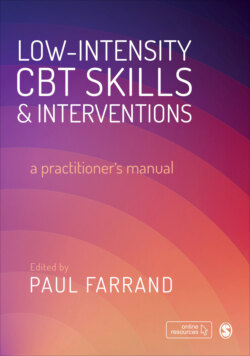Читать книгу Low-intensity CBT Skills and Interventions - Группа авторов - Страница 88
На сайте Литреса книга снята с продажи.
Clinical Example Questions to Elicit Symptoms of the Presenting Problem
ОглавлениеPhysicalDo you notice any sensations in your body when you have a panic attack?When you're feeling low, do you notice anything is going on in your body?
BehaviouralIs there anything you do when you notice yourself getting worried?What do you do when you are feeling particularly low?
CognitiveHave you noticed any words or images go through your mind when you are feeling worried?When you're particularly low, have you noticed any thoughts or pictures that come to mind?
EmotionalWhen you notice being tired, your legs are heavy and you are off your food, how do you feel emotionally?When you're lying awake, unable to get to sleep, how does that make you feel?
Symptoms explored will vary according to the problem formulation model adopted, between a specific focus on physical (Autonomic), Behavioural, Cognitive and Emotional symptoms and description of the wider context within the Five Parts (Padesky and Mooney, 1990) or Five Areas (Williams and Garland, 2002) approaches. Capturing symptoms in this manner can be a useful way to orientate patients to a CBT-informed approach (Figure 2.2).
Figure 2.2 Symptoms of presenting problem represented within the Five Parts Model (5-part model adapted with permission of the author, copyright 1986 by the Center for Cognitive Therapy; www.padesky.com)
